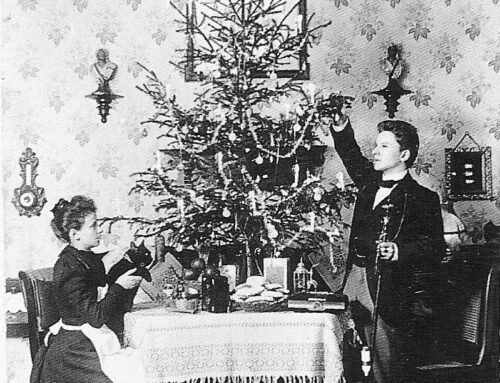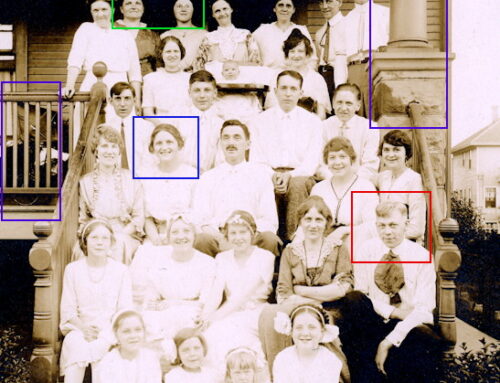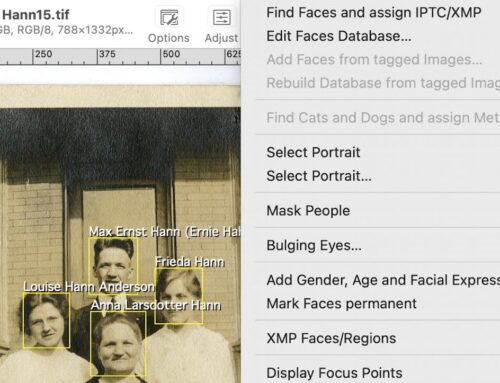The Kahns Tea Store 1909 calendar plate is my Treasure Chest Thursday post.
My mother’s step-grandfather owned this Chicago coffee and tea store. For years, the calendar plate nestled with dozens of other antique plates on my mother’s kitchen plate rail. My parents were avid antique collectors for 50 years. I didn’t think that was so wonderful as a kid. Every weekend car trip seemed to end up at an antique store. The minutes passed like years while my sisters and I waited in the car. But before long, we all shared their appreciation and knowledge of these objects from the past.
Every once in a while, my mother would bring the Kahns calendar plate down from its lofty perch. She’d talk about Grandpa Kahns fondly. He stocked candy in his Chicago store and gave her rides to school in his very own car, making my mother the envy of her classmates.
But even as a teenager, I was confused about this German Grandpa Kahns. The grandpa I’d heard of was Austrian and named Hann. Kahns? Hann? Kahn? Hahn? Had he changed his name? Were we German or Austrian?
Separating Kahns from Hanns
After 1977, when I began my family history research, these confusing grandpas resolved themselves into two different sides of the family. Gottfried Hann was my father’s grandfather, who came from Austria. Little else was known about him because he died two months before my paternal grandmother was born.
On my mother’s side of the family, Carl Wilhelm Kahns married my great-grandmother Anna Schumann Kirschstein. This was the second marriage for them both. Anna and her first husband, Bruno Kirschstein, had four children, the eldest of whom was my grandmother, Edith. The Kirschsteins acrimoniously divorced in 1905. This fact was shrouded in shame, little spoken of even years after the fact.
A few years ago, my mother entered assisted living, her antiques auctioned off, and her house, where we had lived since 1951, sold. I determined to stay out of the inevitable dramas that occur when fractured families divide heirlooms. So I asked my mother for just one thing: the Kahns tea store 1909 calendar plate.
The Tea Store
The Kahns tea store was undoubtedly typical of independent mom-and-pop stores that sprang up in Chicago immigrant neighborhoods in the late-nineteenth and early-twentieth centuries. According to The Encyclopedia of Chicago:
As residents moved into neighborhoods segregated by class and ethnicity and into the suburbs created by the new street railways and railroads, small family-run stores sprang up to meet their needs. These new groceries, meat markets, vegetable stands, and bakeries typically reflected the ethnic demographics of the neighborhood…. Stores often carried ethnic foods that were hard to find elsewhere and conducted business in the native language of their customers. Workers followed this pattern as well. The bakers’ union had separate locals for its German, Bohemian, Scandinavian, Polish, and English members, while the meat cutters had separate German, Bohemian, Jewish, and African American locals.

“Bingo! $29 Gone!,” The Day Book (Chicago, Illinois), 30 Jan 1917, p. 7.
Today, a Walgreen’s parking lot occupies the Milwaukee Avenue site of the Kahns tea store.
A Calendar Plate Example
Small merchants like Charles Kahns offered calendar plates as complimentary gifts to customers. (Fair warning: don’t click that calendar plate link unless you need another collection in your life.) Most common between 1906 and 1921, calendar plates peaked in popularity in 1910. Gibson Girls, submarines, the Panama Canal, biplanes, children, the outdoors: the subjects depicted in the center of calendar plates seem almost infinite. Most calendar plates were produced in East Liverpool, Ohio. But Grandpa Kahns, true to his roots, gave away Dresden china calendar plates.
Finding Charles William Kahns
My German genealogical research skills improved as I searched for Charles William Kahns. The Kahn family emigrated from Schleswig-Holstein to Chicago in 1869. There they Anglicized their forenames and added an “s” to their surname.
Supposedly born in Hamburg, Carl Wilhelm August Kahn actually was baptized on 27 Nov 1859 in Mölln, in Schleswig-Holstein. His parents appeared as Henry Kahns and Elizabeth Mary Dray in family records, born in Berlin and Mecklenburg respectively. In reality, Joachim Heinrich Kahn was also from Mölln. His wife, Margaretha Sophie Elisabeth Drews, was from Wedendorf, Mecklenburg.
Fortunately, Schleswig-Holstein records are well represented in Ancestry’s “Deutschland, Ausgewählte Evangelische Kirchenbücher 1500-1971” database, leading straight to the parish records for the Kahn family.

Baptism of Carl Wilhelm August Kahn, 27 Nov 1859, Lauenburg u Mölln Taufen 1855-1872 Kirchenbuch, p. 93.
Charles became a widower on 23 Mar 1927 with the death of his first wife, Minnie Hoffmann. I don’t know how Charles and my great-grandmother Anna met, but on 22 Nov 1927, they married. According to my mother, her grandmother Anna Friedrike Luise Schumann Kirschstein Kahns was rather tough sledding, a dominant personality, who was extremely devoted to evangelist Billy Sunday, who described himself as “an old-fashioned preacher of the old-time religion.”
When Charles died in 1938, his family made no mention of his second wife in the death notice in the Chicago Tribune. Charles was buried next to Minnie in Arlington Cemetery in Elmhurst. Anna was interred next to her ex-husband Bruno Kirschstein at Forest Home Cemetery in Forest Park.
The Fate of the Plate
As for the Kahns Tea Store 1909 calendar plate, now it sits on my plate rail, part of my family history. To me, this plate is a living connection to my family history. It’s not just something purchased for money from an antique dealer. It also neatly symbolizes the all of the pleasure I’ve had researching my family history. And alone among my living relatives, I have turned the names I’d heard for years into real people.






I remember Garfinckels, but I think Kahn’s was long gone by the time I lived in DC. That’s amazing that your mother had that pattern, too, Jane. It’s nice to know that Charles Kahns gave away the good stuff!
I am fascinated by this post! Two reasons: my mother had that same Dresden china pattern AND there was a Kahn’s department store in Washington DC when I was a mere child! I cannot help but wonder if that store was started by a relative (ancestor) of yours! I don’t remember when the stores disappeared but I suspect it was sometime in the early 1960s.